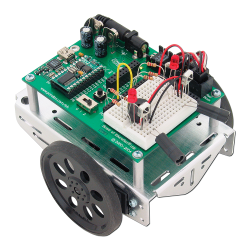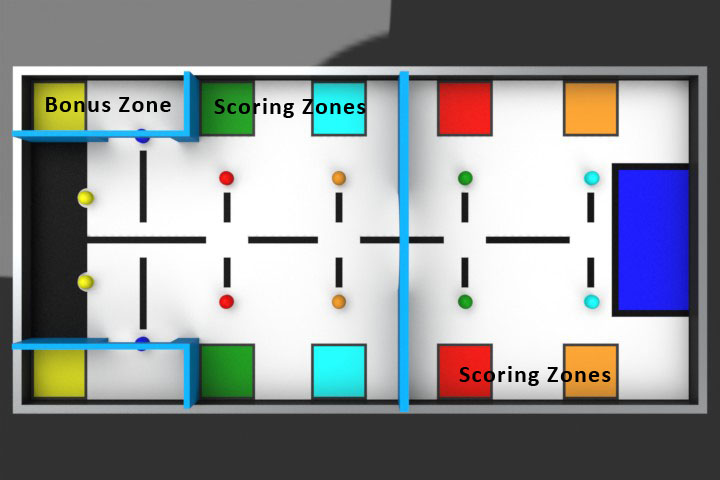

This challenge consists of distributing the colored balls into the different scoring zones of the field. Each ball must be taken into a matching color zone.
Boe-Logistics is is a concept developed by SmartCubo Torneo Nacional de Robotica. Visit www.SmartCubo.com for details.
Boe-Bot Hardware Rules
- Each robot must use one of the eligible Boe-Bot hardware kit options that uses the Boe-Bot Chassis and Parallax Continuous Rotation Servos:
- BASIC Stamp-based Boe-Bot Robot Kit Serial (#28132) or USB (#28832)
- Robotics Shield Kit for Arduino (#130-35000)
- Robotics with the Boe-Bot Parts Kit (#28124) PLUS one of the following:
- Propeller Board of Education (#32900)
- BASIC Stamp HomeWork Board Serial (#555-28158) or USB (#555-28188)
- The only contestant-designed part of the robot will be a ball manipulator. This manipulator should not be bigger than 10 by 10 by 10 cm. The judges will inspect the manipulator and it must fit into a cube of those dimensions. The manipulator can be made out of any material, as long as it doesn’t represent a possible damage to the field.
- The manipulator can extend its size, once the game has started, but in the beginning of the match, it must be inside an invisible cube of 10 by 10 by 10 cm. A counterweight outside of this invisible cube that does not go past the sillouhette of the Boe-Bot is permitted.
- In the case that the judges decides that the manipulator represents a possible damage risk to the field, the manipulator one must be modified until the judges allow it.
- The Boe-Bot may be powered by a 4-cell or 5-cell AA batery pack, with our without a Boe-Boost module (#30078). ALL ROBOTS MUST CONNECT SERVOS TO REGULATED 5 VDC. Contestants must show the judge that the servos are using a 5 VDC input. If the servos are not connected to 5 VDC, the contestant must modify the circuits and have them verified by a judge before participating.
- The robot can only have two Parallax Continuous Rotation Servos. No other types of motors or additional motors are allowed.
- Only these sensors are allowed:
- 8 Infrared (IR) LED assemblies (#350-00017) and Infrared Receivers (#350-00014)
- 4 Phototransistors (#350-00029)
- 4 QTI Line followers (#28108)
- 1 PING))) Ultrasonic Distance Sensor (#28015)
- 2 whisker sensors (included in Boe-Bot kits)
- 2 Pushbuttons (included in Boe-Bot kits)
- No limit of electrical components such as LED’s (not infrared), piezospeakers, resistors, capacitors, et cetera
The Game Rules
- The game has a length of 3 minutes (3:00).
- During this time the robot must many balls as possible into their matching-color zones.
- If a ball is delivered into a different color zone, it will not be considered for the final score.
- In the field are several indicators that will help the robot to navigate and to know when the ball is delivered into a zone.
- These indicators are black lines on white. These lines have a thickness of about an inch. These lines can present discontinuities.
- The balls and their matching zones will always be in the same positions relative to each other as shown in the images. However, the actual colors may be different during the competition. For example, in the images, the Starting Zone is dark blue, and the dark blue balls are in the doorways to the Bonus Zones. During the competition, if the Starting Zone is orange, then orange balls would be in the doorways to the Bonus Zones.
- In addition, the track presents walls and obstacles as navigation challenges for the robot.
- It is allowed to use IR remote controls, such as the TV controller, to initialize the robot. If the team wants to use IR it is under their own responsibility. Interferences and communication problems will not be taken into consideration by the judges.
- IR remote control only can be used at the beginning of the robot’s rountine. Once the robot is out of the start zone, IR remote control cannot be used.
- Other methods of remote control are not permitted.
- The start zone is the only zone where the robot can be manipulated by the contestants. Out of this zone the robot can’t be touched.
- In case that the robot gets stuck in the field, if the remaining time is more than a minute, the robot can be manipulated by the contestants, taking as penalty the game object that was intended to manipulate. This can happen as many times in the game as needed, as long as there is more than a minute remaining. If the time is less than a minute, no penalty will happen, but the game is over for that team.
- Example: The robot is going for a blue ball, but in the middle of the field the robot seems to get stuck against a wall. If the remaining time is:
- 1:01 min, the judge will allow the team to pick up the robot and set it again for another goal, but the blue ball will be taken by the judge. If the ball was scored in the previous movement before getting stuck, it will also be taken by the judge.
- 1:00 min, The same as the previous example.
- 0:59 min, the game is over for the team, and if the blue ball was scored, this time it will count, but the game is ended.
- Example: The robot is going for a blue ball, but in the middle of the field the robot seems to get stuck against a wall. If the remaining time is:
- In case that the robot gets stuck in the field, if the remaining time is more than a minute, the robot can be manipulated by the contestants, taking as penalty the game object that was intended to manipulate. This can happen as many times in the game as needed, as long as there is more than a minute remaining. If the time is less than a minute, no penalty will happen, but the game is over for that team.
- The time doesn’t stop at any moment.
- The start zone is a 50 by 25 cm space.
- The contestants can put into this space any object that they want. This includes rules or guides for the proper accommodation of the robot.
- The Start Zone is indicated by a 5 cm black line.
- To be considered inside the Start Zone, objects must be completely inside the black line, and can’t touch the line.
- If the robot is handled while over the black line, and not completely in the Start Zone, the penalty will be the same as the rule of robot manipulation explained before.
- Any object inside the Start Zone, including the robot and any balls that have been moved there by the robot, can be handled and repositioned within the zone.
- To be considered inside the Start Zone, objects must be completely inside the black line, and can’t touch the line.
- The scoring zones are located all over the field and their size is 18 by 18 cm, surrounded by a 2 cm black line. The only different scoring zone is the start zone, 50 x 25 cm.
- The balls will be considered scored when they are inside of the scoring zone, touching the colored area and not the black line. If the robot takes any ball out of the zone and doesn’t put it back, the ball will not be taken as scored.
- If the ball gets out of the scoring zone by a movement of the table or anything that doesn’t involve a robot, it will be counted as a scored ball.
- The scores are:
- Scoring zone: 5 points per ball that is the same color as the zone.
- Start Zone: 7 points per ball that is the same color as the zone.
- Bonus Zone: 10 points per ball that is the same color as the zone.
Download Competition Field Dimensional Drawings (PDF)

About the Competition
The competition is divided into 2 stages.
- Qualification: All the teams will play in these rounds. They will play as many games as possible to get the best run. When the qualification is over only the best 10 teams will pass to the finals. In case of a tie the second best run will determine the position.
- Finals: Each one of the 10 teams will have another 2 chances. These rounds will be accumulative. At the end of the 20 rounds the best team with the two added scores will be the winner. The qualification ranking will be used for a tie.
These are the images of the field
Note: The zone and ball colors may be different during the competition However, every ball would still in the same position relative to its matching color zone.
